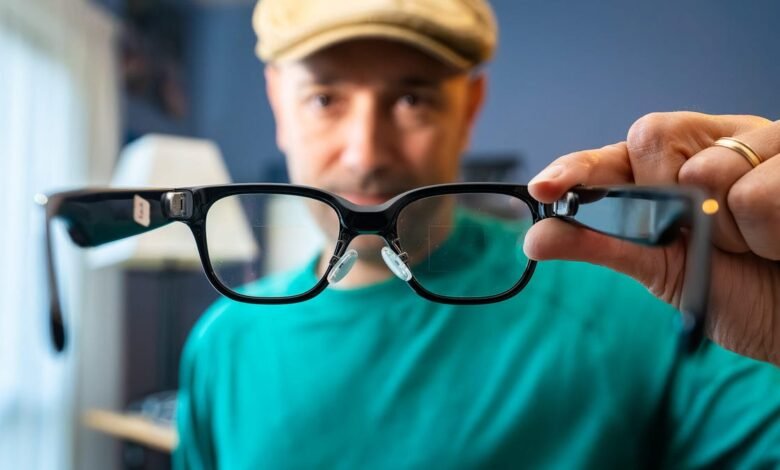Meta Ray-Ban rivals: Better, cheaper alternatives tested

▼ Summary
– Meta Ray-Ban Display smart glasses are limited to the US, have long back-orders, and Meta plans to produce only 150,000-200,000 units over two years.
– Rokid Glasses are a $599 alternative available globally via Kickstarter, with over 300,000 pre-orders and features like live translation in 89 languages and a brighter display.
– Rokid Glasses outperform Meta’s in comfort, translation capabilities, photo/video options, AI engine (ChatGPT), and support for a wider range of prescription lenses.
– Meta Ray-Ban Displays excel in live conversation captioning, full-color photo previews, superior sound quality, discreet display, transition lenses, style, and a neural interface wristband.
– Both products are for tech enthusiasts, with Rokid being more functional and affordable, while Meta offers a more futuristic and stylish design.
For those seeking smart glasses with a built-in display, the Meta Ray-Ban Display presents significant availability hurdles, being restricted to the US market with lengthy backorders and limited production numbers. Fortunately, a compelling alternative exists in the Rokid Glasses, which are accessible globally, cost $200 less, and offer several unique capabilities not found in Meta’s offering. Having tested both, it’s clear each has distinct strengths and weaknesses worth examining.
The Rokid Glasses currently have a Kickstarter pre-order campaign that has surpassed $3 million, with over 300,000 pairs reserved worldwide. They are scheduled to retail for $599 upon their November release. My testing reveals several areas where Rokid outperforms Meta.
Where Rokid Glasses excel
Comfort and weight stand out immediately. Weighing just 49 grams compared to the Meta glasses’ 69 grams, the Rokid model feels noticeably lighter. Their design incorporates nosepads that lift the frames slightly off your nose, enhancing comfort during extended wear.
Live translation is a major advantage. Powered by Microsoft’s translation software, Rokid supports an impressive 89 languages. In contrast, Meta’s glasses currently handle only five, with plans to add Portuguese and Japanese later. During my tests, Rokid’s translations proved quite useful for grasping essential meaning in conversations where I otherwise would have been lost.
Photography and video options are more versatile with Rokid. While Meta restricts users to 4×3 vertical shooting, Rokid provides multiple aspect ratios including 9×16 vertical and, importantly, 3×4 horizontal formats. I found myself consistently choosing horizontal mode during testing for its practical benefits.
The AI engine represents another key difference. Rokid utilizes ChatGPT for its artificial intelligence, offering more advanced capabilities than Meta’s proprietary Llama models. That said, the ChatGPT implementation still shows some software bugs in early units, particularly with follow-up questions and occasional audio response glitches.
Display brightness proves surprisingly effective. Although Rokid uses a 1,500 nit monochrome green display in both eyes versus Meta’s 5,000 nit color display in one eye, the Rokid screen appears brighter and more readable in real-world conditions. The ability to adjust text positioning and brightness further enhances functionality.
A built-in teleprompter feature adds significant value for content creators, speakers, and meeting leaders. The system automatically advances text as you read, functioning well enough for regular use. The only drawback is that the display remains somewhat visible to observers.
Prescription lens support is far more comprehensive. Rokid accommodates prescriptions from +16 to -16, compared to Meta’s limited +4 to -4 range. The magnetic lens system allows easy swapping if your prescription changes or if you prefer wearing contacts with the glasses.
Where Meta Ray-Ban Display glasses have the edge
Live conversation captioning works remarkably well, displaying real-time captions of in-person discussions. This feature proves invaluable in noisy environments where understanding speech becomes challenging.
Photo and video previews benefit from Meta’s full-color viewfinder, providing a significant advantage over Rokid’s basic visual guides. This elevates the photography experience to a more professional level.
Audio quality demonstrates clear superiority. Both sound output and microphone performance on Meta glasses deliver exceptional clarity and depth that surpasses Rokid’s capable but less impressive audio system.
Display visibility to others is nearly nonexistent with Meta glasses, which claim only 2% light leakage. During testing, I couldn’t detect when someone was using the display. Rokid glasses show obvious green light movement during use, and their prism lenses reflect light in ways that constantly signal their technological nature.
Transition lenses come standard on all Meta models, automatically darkening outdoors to function as sunglasses. Rokid currently offers no comparable option.
Style considerations favor Meta significantly. While Rokid partnered with Bolon Eyewear (owned by Ray-Ban’s parent company) for frames resembling the classic Wayfarer design, they only come in glossy black. Meta offers multiple styles including an attractive transparent brown option. Meta glasses sit directly on the nose like conventional eyewear, whereas Rokid’s elevated positioning can appear slightly awkward. Most importantly, Meta glasses look nearly identical to regular sunglasses aside from small cameras and subtle lens lines.
The Neural Band interface represents a potential breakthrough, allowing control through hand gestures like pinches, swipes, and wrist rotations. I found the gestures intuitive and quickly memorized the most common ones. However, wearing a dedicated wristband that only controls glasses feels limiting compared to a multi-purpose device.
Final considerations
Neither product qualifies as essential for average consumers yet, serving better as early-adopter technology for enthusiasts. However, Rokid’s live translation feature stands as a notable exception, it could prove incredibly valuable for international travelers or anyone regularly communicating across language barriers, offering translation capabilities beyond what current smartphones provide.
While Meta’s glasses feel more futuristic and stylish, Rokid delivers greater functionality and practical utility at a lower price point. The $200 savings, combined with Rokid’s current Kickstarter discounts, make them an attractive option for those prioritizing features over fashion in today’s smart glasses market.
(Source: ZDNET)





